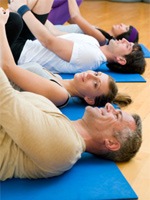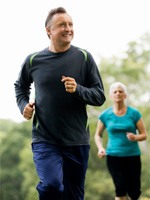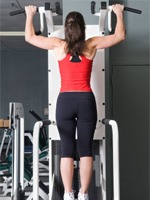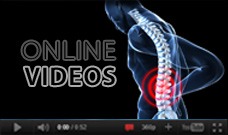Exercise Benefits
Benefits of Exercise in Back Pain Prevention
The best way to treat low back pain is to prevent it, and preventing back pain requires exercise aimed at building a stronger body and, as a result, a stronger back. We all struggle to find time in our busy lives for exercise but, with determination, a little time each day, and a schedule, you will be on your way to a stronger, healthier, and happier body and back. Whether your goal is to prevent back pain or treat existing pain, a complete total-body workout will be a positive addition to your lifestyle.
Exercise benefits our health in many ways. It increases blood flow to our heart and muscles, reducing lactic acid and other breakdown products more efficiently, and delivers increased oxygen and nutrients to the damaged muscle. It strengthens the muscles, tendons, and ligaments which hold our bones, and in particular, our spine, together; this reduces stress on the bones and joints and promotes the release of endorphins to the brain. Besides the obvious physical benefits, exercise makes us feel better too.
A well-rounded exercise regimen consists of:
- Warm Up and Stretching
- Cardiovascular Activity and Cool Down
- Strength Training
REMINDER: Consult your physician before beginning any exercise program. If pain develops, stop immediately and notify your physician.
Components of a Good Exercise Routine
Warm Up and Stretching
 It is important to undergo a warm up session and a stretching session prior to any exercise. It is not necessary to break a sweat during your warm up; the goal is to get the muscles warm and heart rate at about one hundred. A warm up can be a walk, jog, bike or whatever you enjoy at a light to moderate intensity level and usually lasts about ten minutes. It is important to undergo a warm up session and a stretching session prior to any exercise. It is not necessary to break a sweat during your warm up; the goal is to get the muscles warm and heart rate at about one hundred. A warm up can be a walk, jog, bike or whatever you enjoy at a light to moderate intensity level and usually lasts about ten minutes.
It is important to follow the warm up with stretching. Be sure to stretch the back, chest, shoulders, arms and legs. Stretching can easily be done on your own but most gyms have chairs designed to provide an optimum stretch. If you do not have access to a gym, resistance can be provided by a wall or doorway to stretch various muscle groups like the pectorals, biceps and triceps.
Cardiovascular Activity
 For cardiovascular activity, the goal is duration, not intensity. Walk briskly for twenty to thirty minutes or take an easy jog. Remember, duration first, speed will follow. While a person in good shape may target an exercise heart rate of 85 percent of their maximum, a person in lesser shape might target 60 percent. COOL DOWN after each cardiovascular session with a slow walk until your heart rate is below 100. For cardiovascular activity, the goal is duration, not intensity. Walk briskly for twenty to thirty minutes or take an easy jog. Remember, duration first, speed will follow. While a person in good shape may target an exercise heart rate of 85 percent of their maximum, a person in lesser shape might target 60 percent. COOL DOWN after each cardiovascular session with a slow walk until your heart rate is below 100.
Monitoring your heart rate:
Cardiovascular Activity
For cardiovascular activity, the goal is duration, not intensity. Walk briskly for twenty to thirty minutes or take an easy jog. Remember, duration first, speed will follow. While a person in good shape may target an exercise heart rate of 85 percent of their maximum, a person in lesser shape might target 60 percent. COOL DOWN after each cardiovascular session with a slow walk until your heart rate is below 100.
Monitoring your heart rate:
While the only truly accurate method to calculate maximum heart rate is a stress test, a practical method is as follows:
Men: 220 minus your age + add 10 points if you are already fit
Women: 226 minus your age + add 10 points if you are fit
To measure pulse, use the wrist measurement, not the carotid artery in the neck as pressure on the carotid artery may cause a vagal response and slow the rate by 10 beats per minute.
Consult a physician before starting any workout program and guide workouts according to your level:
-Beginner (over 30 years of age, overweight, sedentary for 10 years): it will take about 6 months to get your body conditioned to run and you should not work out above 70% of maximum heart rate
-Intermediate: workouts should be around 80 to 85% of maximum heart rate with short interval bursts of exercise at up to 90%
Choosing the appropriate cardiovascular activity
For those with low back pain and herniated discs, running or walking is better than riding a stationary bike as the sitting position puts stress on the low back and may worsen low back pain.
Strength Training
 Strength training is the cornerstone of a healthy back and a healthy body. It can help to: Strength training is the cornerstone of a healthy back and a healthy body. It can help to:
- Accelerate weight loss
- Reduce back pain
- Prevent injury
- Reduce osteoporosis
Weight loss
Muscles burn more calories than fat does; a lean body, low in fat relative to muscle, will burn calories more efficiently. Many people underestimate the value of strength training in weight loss, but it is a crucial part of creating a stronger, leaner body.
Back pain reduction and injury prevention
A strong back, with stronger muscles, ligaments, and tendons, is naturally more resistant to injury than a weak back. While cardiovascular activities deliver additional oxygen to the muscles, only strength training can actually thicken muscle cells. Stronger muscles, tendons and ligaments create a stronger back, and a stronger back means better posture, better support of the spine, and reduced pain.
Osteoporosis
The weakening of bone, which is common with the natural aging process, has been shown to be significantly slowed by strength training. According to Wolff's Law, constant stress on bone actually causes the bone to grow stronger over time; similarly, strength training can create stronger bones. |




 It is important to undergo a warm up session and a stretching session prior to any exercise. It is not necessary to break a sweat during your warm up; the goal is to get the muscles warm and heart rate at about one hundred. A warm up can be a walk, jog, bike or whatever you enjoy at a light to moderate intensity level and usually lasts about ten minutes.
It is important to undergo a warm up session and a stretching session prior to any exercise. It is not necessary to break a sweat during your warm up; the goal is to get the muscles warm and heart rate at about one hundred. A warm up can be a walk, jog, bike or whatever you enjoy at a light to moderate intensity level and usually lasts about ten minutes. For cardiovascular activity, the goal is duration, not intensity. Walk briskly for twenty to thirty minutes or take an easy jog. Remember, duration first, speed will follow. While a person in good shape may target an exercise heart rate of 85 percent of their maximum, a person in lesser shape might target 60 percent. COOL DOWN after each cardiovascular session with a slow walk until your heart rate is below 100.
For cardiovascular activity, the goal is duration, not intensity. Walk briskly for twenty to thirty minutes or take an easy jog. Remember, duration first, speed will follow. While a person in good shape may target an exercise heart rate of 85 percent of their maximum, a person in lesser shape might target 60 percent. COOL DOWN after each cardiovascular session with a slow walk until your heart rate is below 100. Strength training is the cornerstone of a healthy back and a healthy body. It can help to:
Strength training is the cornerstone of a healthy back and a healthy body. It can help to:






